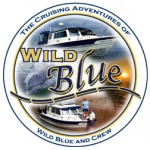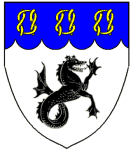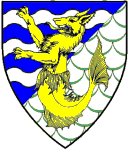| View previous topic :: View next topic |
| Author |
Message |
Dora~Jean
Joined: 09 Mar 2004
Posts: 1504
City/Region: Simi Valley
State or Province: CA
C-Dory Year: 2003
C-Dory Model: 25 Cruiser
Vessel Name: Dora~Jean
Photos: Dora~Jean
|
 Posted: Fri Jun 02, 2006 2:48 am Post subject: Posted: Fri Jun 02, 2006 2:48 am Post subject: |
 |
|
Pete, good points, I always try to put myself in the other person's (boat's) shoes to visualize what options they have as well. Thanks for the links, I'll try them this weekend.
Your statement | Quote: | | Since the hull is shallow, about flat and the windage above the water quite high, the force of the water doesn’t transfer to the boat and the waves slid under the boat harmlessly |
I don't completely agree. The C-Dory's, including the 25's have actually quite low profiles to the water, they don't have a bilge that the rest of the boat is built over. They are bow-light however, so what forward windage they do have seems to be magnified. I find this low profile a major advantage, especially after enduring 50-70 knot winds at anchor.
I and other C-Dory owners experience the same tremendous stability of these boats due to their hull shape. I read a discussion a few years back regarding broaching in beam-on seas. The C-Dory's tend to 'slide' down the waves rather than tripping on a deep-V and rolling. That short, thin keel provides just enough tracking but not so much to want to trip and roll the boat over. Now if we're talking large, breaking waves, I don't think any shape will be 100% safe (Perfect Storm comes to mind...).
| Quote: | | ...how does the boat behave without power in scary rough conditions? |
I can't say I've been in 'scary rough conditions' without power, but I did intentionally shut off the engines in 6-8 ft combined seas (swell/chop) with serious whitecaps, about 20-25 kts of wind. The boat turned tail to the wind and stabilized so well I decided to boil water and make a cup of noodles for lunch -- and ate it while riding the waves. Amazing stability. I'd rather have it turn and hold directly INTO the wind and waves, but will take this behavior way before any of my other boat's that ALL turned SIDEWAYS to the waves/wind.
_________________
Steve & Carmen
"Great works are performed not by strength, but perseverance" (Samuel Johnson)
Dora~Jean C-Dory 25 2002-Present
Corsair F-31 Trimaran 1996-2002
MacGregor 26X 1988-1996
Glaspar Seafair Sedan 18 (2)
StarCraft 19 & 22
Catalina 17 & 22
Crestliner 19
+4 Previous, 1/2 sail, 1/2 power |
|
| Back to top |
|
 |
CAVU
Joined: 02 Nov 2003
Posts: 665
City/Region: Spokane
State or Province: WA
C-Dory Year: 2002
C-Dory Model: 22 Cruiser
Vessel Name: CAVU
Photos: CAVU
|
 Posted: Fri Jun 02, 2006 12:37 pm Post subject: Posted: Fri Jun 02, 2006 12:37 pm Post subject: |
 |
|
Pete,
My experience with bottom fishing jives with Steve's comments above. I like to jig for halibut with power off and drifting. I have fished in some very large swells and chop. If there is any wind the boat will turn with the bow straight downwind and unless the wind chop is very high the waves just roll under with no effect. The worst I have ever seen happen is an occasional little crest will break in the splashwell but very little water has ever come aboard.
_________________
Ken Trease
22 CD Cruiser, CAVU
Twin 40HP Hondas |
|
| Back to top |
|
 |
Dora~Jean
Joined: 09 Mar 2004
Posts: 1504
City/Region: Simi Valley
State or Province: CA
C-Dory Year: 2003
C-Dory Model: 25 Cruiser
Vessel Name: Dora~Jean
Photos: Dora~Jean
|
 Posted: Sat Jun 03, 2006 1:40 am Post subject: Posted: Sat Jun 03, 2006 1:40 am Post subject: |
 |
|
| Ken, you're the first CD-22 owner that I recall reporting this same action that I've experienced on my 25 (although I don't claim to have exceptional recall abilities..). Great. I have twin engines, do you? I would think that adds to its tendency to turn downwind. Like I said, first boat I've owned that does it, wonderful safety factor plus less of a tendency to become disabled from seasickness if trying to fix a problem in bad conditions. |
|
| Back to top |
|
 |
Greg S
Joined: 05 Feb 2004
Posts: 12
City/Region: Auburn
State or Province: CA
C-Dory Year: 1988
C-Dory Model: 22 Cruiser
Vessel Name: Sandra Dee
|
 Posted: Sat Jun 03, 2006 11:15 am Post subject: Posted: Sat Jun 03, 2006 11:15 am Post subject: |
 |
|
Back to the big wave. I gotta know, what's the WORST thing you could do in that situation, and what might have happened? (Just bought a 22 Cruiser and will be taking a day of instruction in the Bay next week--I have zero "big water" experience except party boats, so this story really got my attention.)
Greg
Roseville, CA
_________________
C-Dory Addict
88 22'Cruiser, Honda 90 & 9.9 |
|
| Back to top |
|
 |
JamesTXSD
Joined: 01 Mar 2005
Posts: 7445
City/Region: from island boy to desert dweller
State or Province: AZ
C-Dory Year: 2007
C-Dory Model: 25 Cruiser
Vessel Name: "Wild Blue" (sold 9/14)
Photos: Wild Blue
|
 Posted: Sat Jun 03, 2006 12:17 pm Post subject: Posted: Sat Jun 03, 2006 12:17 pm Post subject: |
 |
|
This is a really interesting thread for me - thanks, everyone, for your participation. In sailing, if something needs attention when the weather is snotty, you can heave to, things will settle down, and you can go about reefing, repairing, having lunch, etc. Also, on occasions where there is very little wind/wave action, we have anchored from the stern to get some breeze in the companionway (we do NOT make a practice of this).
So, if I am understanding correctly from what Steve, Pete, and Ken are saying: there isn't a problem with being pooped in these boats (assuming the waves are not breaking) because the hull is flat, the transom wide, and not much boat below the water? Interesting design premise. How much "bucking" is there with any sizable wave action in this position? And what is the drift you'd expect? How fast does the cockpit of the 25 drain if any water comes in?
I gotta tell you, the more I learn about these boats, the more impressed I am. I am so excited to get my hands on ours that I could just about burst. 
I have really enjoyed my chosen profession for the past 31 years, and thought that I'd have some regrets as the ending time grew near. Instead, I find that we (not just me) are so excited to start this next chapter with this boat.
Best wishes,
Jim B.
_________________
Jim & Joan
CD-25 "Wild Blue" (sold August 2014)
http://captnjim.blogspot.com/
 |
|
| Back to top |
|
 |
Dora~Jean
Joined: 09 Mar 2004
Posts: 1504
City/Region: Simi Valley
State or Province: CA
C-Dory Year: 2003
C-Dory Model: 25 Cruiser
Vessel Name: Dora~Jean
Photos: Dora~Jean
|
 Posted: Sat Jun 03, 2006 12:59 pm Post subject: Posted: Sat Jun 03, 2006 12:59 pm Post subject: |
 |
|
I don't claim to be an expert in any of this, so I can only give you my experiences and thoughts. I have a CD25 which of course most of you know it is "self-bailing." I qualify that because, my vintage boat ('03) is open under the transom ledge (inside cockpit) whereas the newer models have that area closed off. I like my area, can put large items in there easily. Back to the open area, there are 4 rather large entry holes at the back of this area that go directly to the bilge area where the gas tank is. I believe the 4 holes/entries (approx 6"x6" semi-circle shaped) are to pass hoses and cables from above deck to the bilge area. Factory said I could seal them off, not used for venting. That I plan to do (on my list). I believe that's the "archilles heel" of my boat which has an easy remedy. So far never had a wave enter the cockpit, only splashes from wind whipping.
As far as what is the worst you could do in that wave we were in? --hmmm, I suppose turn tail and put in full reverse!!! Sorry, got carried away. I wouldn't recommend putting in neutral and turning sideways to the wave, that's an uncontrolled situation, could broach -- although I really believe my boat would've handled it OK even then -- not sure of the passengers though... And I don't plan on running an experiment thank you very much.  |
|
| Back to top |
|
 |
Helen O
Joined: 30 Oct 2003
Posts: 555
City/Region: Cathlamet
State or Province: WA
C-Dory Year: 1993
C-Dory Model: 16 Angler
Vessel Name: Helen O'
Photos: Helen O'
|
 Posted: Mon Jun 19, 2006 2:56 am Post subject: Posted: Mon Jun 19, 2006 2:56 am Post subject: |
 |
|
When heading into steep or breaking waves, the least broachable position is to head directly into the wave. The further you get from the 90 degree angle, the more likely the possibility of a broach. If you don't believe it, just look closely at the photo that Tyboo posted on page 2 of this thread. That is what a 45 degree angle will get you. Boats have a pointy shaped bow for a reason and that reason is to arrow through the breaking water or steep wave. You don't want a wave to hit the side of the bow, that forces the bow parallell to the wave and the potential to broach increases. If you're going to fast you'll drop off the back of the wave and land with a splat , but you'll live to tell about it.
Watch "Graveyard of the Pacific" on the travel channel. The Coast Guard recommends taking big waves head on.
_________________
Larry S
Helen O'  |
|
| Back to top |
|
 |
Dora~Jean
Joined: 09 Mar 2004
Posts: 1504
City/Region: Simi Valley
State or Province: CA
C-Dory Year: 2003
C-Dory Model: 25 Cruiser
Vessel Name: Dora~Jean
Photos: Dora~Jean
|
 Posted: Tue Jun 20, 2006 12:20 am Post subject: Posted: Tue Jun 20, 2006 12:20 am Post subject: |
 |
|
| Larry (Helen O) - thanks, I learned something AGAIN. I agree with you, the boat and passengers will take a pounding head on, and that next wave may break right on top of the boat, but that is the best way to stay 90 deg to the wave and the next one. That means Pounder negotiated the wave the best and Salty-C's chose prudence the best. |
|
| Back to top |
|
 |
Falco
Joined: 20 Dec 2004
Posts: 164
City/Region: Flagstaff
State or Province: AZ
C-Dory Year: 2004
C-Dory Model: 22 Cruiser
Photos: Bucking Coho
|
 Posted: Wed Jun 21, 2006 8:20 pm Post subject: Posted: Wed Jun 21, 2006 8:20 pm Post subject: |
 |
|
This thread makes me nervous. I'm no expert here, but just based on my experience and what I've learned over the years (including a head splitting, adolescent-like run in with a wake from a Canadian destroyer), IMHO:
You should never, ever put your stern to heavy seas - especially in an outboard which tends to be naturally ass heavy. Even if all seems well, a single large or breaking wave will take you down - in an instant. If I were ever forced to do tihs I would never shut off my power plants in hopes I might be able to readjust position if I see something nasty heading my way.
In deciding "how to take" a wave or wake, due consideration should be given not just to wave height, but also wave length (how stacked up the waves are/spacing) and sea conditions (confused, wave shape(s)/breaking, steepness, contributory currents and tides).
There is no single rule for handling waves (or wakes) in any boat. The decision must be made on the spot. There are times when a bow on approach is the only way to proceed (or hold position). There are times when an angled approach (of varying degree) is appropriate. And there are times when turning and following a sea is best. There are times when its best to toss the sea anchor off the bow and let er drift. But none of these can be decided solely on wave height.
Weight distribution on the boat can effect performance in heavy seas, as can adjusting influences like trim tabs (sometimes good into the waves, but almost always bad in a following sea - cause broaching)
The C-Dory suffers from its flat bottom in taking stacked, high peak waves head on because even at very low speed you will pound off the other side of the wave because there's nothing to cut through the trough.
Any boat will capsize - it's just a matter of wave conditions, boat position and seamanship.
As echoed by others - anticipate and avoid these big ships. A C-Dory is nothing more than small, inconsequential piece of flotsam to these behemoths. Shipping lanes are marked for a reason.
C-Dorys are great boats but are not limitation free..
|
|
| Back to top |
|
 |
Sea Angel
Joined: 29 Dec 2003
Posts: 736
City/Region: Virginia Beach, VA
State or Province: VA
Photos: Sea Angel
|
 Posted: Wed Jun 21, 2006 10:49 pm Post subject: Posted: Wed Jun 21, 2006 10:49 pm Post subject: |
 |
|
Falco;
Well said.
What a great thread!
Here on the lower Ches. Bay we have the same problem of traffic, plus the Navy ships and commercial fishing vessels.
Experience is gained by practice in a controlled condition. Ride those waves with various angles in a progression of challenges. Get to know the 'feel' of the boat at different angels of approach. Size up the entry. You will find various 'sweet' spots for the controllability and speed. KEEP the hull and props in the water for control, don't try to make her span between the peaks. It could be possible to pitch pole as you roll over one of the peaks, etc..
You will find that the CD25 WILL flex some. I have had my screens pop out of their tracks and hit me and my mate on more than one occasion. The popping out is not as important as to the ability of the boat to flex and absorb some of the energy. The old NOVA SCOTIA fishing boats were made to do just that. That experience reminded me of my old sailing instructor demanding that everything be secured in place in case... even on our 'drifting' races. The old adage of a clear and clean deck is a safe deck applies everywhere on board.
As to the seaman's eye and keeping an active 'watch', we all goof on that on occassion. That is when your seamanship practice and prayer skills are tested.
One of the most under estimated vessels you can encounter is the attack subs as they pass by. The sail seems so small, but all that hull is moving a lot just under the surface and can generate a wake just like that container ship. Please, be advised, if you had not thought about it.
I thought all I was going to do was say, HI. Boy, did I roll on. Sorry, gang.
_________________
Art ka1rx
CBRAT #208
2005 CD25 #075 SEA ANGEL (SOLD)
USCGAUX (RET), USN(RET)
Broadcast TV ENG(RET)
ka1rx@verizon.net
SKYPE: Art.Bartlett4 |
|
| Back to top |
|
 |
dogon dory
Joined: 10 Jun 2004
Posts: 1321
State or Province: AK
C-Dory Year: 2005
C-Dory Model: 22 Cruiser
Vessel Name: DogOnDory
|
 Posted: Wed Jun 21, 2006 11:32 pm Post subject: Posted: Wed Jun 21, 2006 11:32 pm Post subject: |
 |
|
Sorry, Folks - Post Deleted By Author
Last edited by dogon dory on Sun Mar 02, 2008 6:01 pm; edited 1 time in total |
|
| Back to top |
|
 |
Phantom
Joined: 30 Jan 2005
Posts: 99
City/Region: Danville, Ca.
C-Dory Year: 2005
C-Dory Model: 25 Cruiser
|
 Posted: Thu Jun 22, 2006 12:40 pm Post subject: Posted: Thu Jun 22, 2006 12:40 pm Post subject: |
 |
|
Interesting question. I have no doubt that the analyses are correct.
I'll just throw in my $.02 for whatever it is worth.
My first instructor, back in the fifties, said to always approach waves at the 45 degrees mentioned here.
I followed those instructions religiously for a long time, but for me there are limits to that advice. Depends a lot on the size and type of boat, as well.
I would probably have followed the 45 degree course as advised here, but at some point, particularly in a C-Dory which has no keel worth mentioning, I would opt for the straight-on approach, perpendicular to the wave at slow speed with increasing throttle up the incline.
I would rather take the pounding from cresting the wave and dropping, as opposed to being unable to maintain my angle up a really steep, high wave and falling off on the low side and rolling. I believe the C-Dory is strongest and least likely to be damaged in a head-on encounter.
On a similar sized boat such as a Shamrock, which has a pronounced keel, I would stick with the 45 degrees. It wold be less likely to fall off.
Just my opinion.
_________________
Boat delivered in May, '05 |
|
| Back to top |
|
 |
Sea Wolf
Joined: 01 Nov 2003
Posts: 8650
City/Region: Redding
State or Province: CA
C-Dory Year: 1987
C-Dory Model: 22 Cruiser
Vessel Name: Sea Wolf
Photos: Sea Wolf
|
 Posted: Thu Jun 22, 2006 1:38 pm Post subject: Posted: Thu Jun 22, 2006 1:38 pm Post subject: |
 |
|
Lots of good thoughts here!
The whole discussion reminds me of my sailing/racing experiences:
You can read all you want to about some aspect like this, but only time on the water will teach you what to do intuitively without having to think about it.
And there is absoloutely no substitute for that experience.
But the reading about the choices and possible outcomes will set you up to learn more quickly from your experiences, savinga lot of time, eliminating a lot of trial and error, and maybe saving your day and/or life.
Joe.
_________________
Sea Wolf, C-Brat #31
Lake Shasta, California
  
"Most of my money I spent on boats and women. The rest I squandered'. " -Annonymous |
|
| Back to top |
|
 |
Phantom
Joined: 30 Jan 2005
Posts: 99
City/Region: Danville, Ca.
C-Dory Year: 2005
C-Dory Model: 25 Cruiser
|
 Posted: Thu Jun 22, 2006 2:06 pm Post subject: Posted: Thu Jun 22, 2006 2:06 pm Post subject: |
 |
|
Also, maybe I spent too much time in deep V hulls, but the thought of using trim tabs around really big, steep waves gives me the willies. 
It's questionable whether or not they can be used for positive effect on the front of a wave, and absolutely scary to contemplate on the back side. |
|
| Back to top |
|
 |
Helen O
Joined: 30 Oct 2003
Posts: 555
City/Region: Cathlamet
State or Province: WA
C-Dory Year: 1993
C-Dory Model: 16 Angler
Vessel Name: Helen O'
Photos: Helen O'
|
 Posted: Thu Jun 22, 2006 3:22 pm Post subject: Posted: Thu Jun 22, 2006 3:22 pm Post subject: |
 |
|
| You can take a rolling wave in just about any position, they are not the dangerous life threatening waves that a vertical or breaking wave is. I defy any of you to describe a situation with a vertical or breaking wave that it is better to take it in any other position than head on. Quite simply put, the closer the wave is to vertical or breaking the more important it is to take it head on. It is pure physics. Having a wave break against the side of your bow is going to violently throw the bow parallel with the wave. That is not the position you want to be in. There is no disputing this. A breaking wave hits with tremendous force. It is imperitive that a breaking wave hit the pointed end of the boat rather than the side. |
|
| Back to top |
|
 |
|
|
You cannot post new topics in this forum
You cannot reply to topics in this forum
You cannot edit your posts in this forum
You cannot delete your posts in this forum
You cannot vote in polls in this forum
You cannot attach files in this forum
You cannot download files in this forum
|
|

 Search
Search Private Messages
Private Messages Profile
Profile Log in
Log in Register
Register Help
Help






